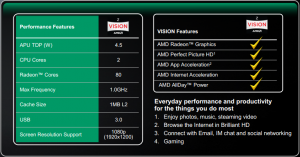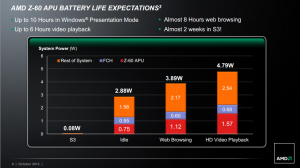Today AMD revealed its Z-60 tablet APU, codenamed “Hondo”, which targets the upcoming Windows tablet platform.
AMD’s goal with the Z-60 APU is to strike a balance between the extreme battery life of ARM tablets and the high CPU performance of Intel-based x86 tablets while at the same time presenting an overall superior tablet experience. The company plans to accomplish this through reduced power and thermal profile over its previous generation APU while still providing gaming-class graphics performance that its competitors can’t touch.
 The Z-60 APU pairs two 1.0GHz Bobcat cores with a Radeon HD 6250 GPU. A maximum resolution of 1920×1200 is supported by the GPU. HDMI output is supported, though it wasn’t clear whether this was as a secondary display or simply a mirrored output.
The Z-60 APU pairs two 1.0GHz Bobcat cores with a Radeon HD 6250 GPU. A maximum resolution of 1920×1200 is supported by the GPU. HDMI output is supported, though it wasn’t clear whether this was as a secondary display or simply a mirrored output.
One of the biggest benefits to the Z-60 APU over its predecessor (the Z-01) is its improved TDP, which has been lowered from 5.9W to 4.5W. The reduction was achieved in part by removing certain components of the Fusion Controller Hub (FCH, similar to the Northbridge in a desktop or laptop) that just doesn’t make sense in a tablet. For example, while USB 3.0 and SATA 6.0Gb/s are supported, the number of ports for each is very limited. The USB 2.0 controller is totally gone (USB 3.0 is backward compatible).
This roughly 23% reduction in TDP allows for a passively cooled tablet, which allows for thinner x86 tablet designs—the Z-60 allows for designs as thin as 10mm. For comparison, the third generation iPad is 0.37″ thick, or about 9.4mm.
 Battery life is affected as well. In an S3 power state, only 0.08W is drawn, leading to a potential two weeks of standby time. For those who actually like to use their tablets, AMD says to expect about eight hours of web browsing, six hours of hardware accelerated HD video playback at 720p (with a fifteen minute reduction at 1080p), and about ten hours in Windows Presentation Mode.
Battery life is affected as well. In an S3 power state, only 0.08W is drawn, leading to a potential two weeks of standby time. For those who actually like to use their tablets, AMD says to expect about eight hours of web browsing, six hours of hardware accelerated HD video playback at 720p (with a fifteen minute reduction at 1080p), and about ten hours in Windows Presentation Mode.
Gaming-class graphics were mentioned, and in the Q&A session, folks weren’t going to let this claim go without specifics. While exact numbers weren’t readily available, an estimated 5-6x performance over Intel’s current Cedar Trail GPUs was given. When asked about its followup, Clover Trail, AMD offered a confident prediction that the Z-60’s GPU would compare very favorably to Intel’s offering. As an example, Modern Warfare 2 reaches a playable 30fps at medium settings with a resolution of 1024×768.
So when can we expect to see Z-60 tablets? The APU itself ships to customers today. Product announcements should start rolling in this week, possibly as early as today. Actual tablets could arrive as early as October 26, the official release date of Windows 8.
Miscellaneous bits
The Z-60 CPU cores are 64-bit. A maximum of 8GB of DDR3-1066 RAM is supported by the memory controller.
Currently no support is planned for Linux or Android, though it’s really just a matter of time before the open source community figures out a way to get it done.
Pricing information wasn’t available as of publishing, though it would be reasonable to guess Z-60 tablets would be priced between ARM- and Intel-based tablets.
Form factors should cover the entire range of tablet types: slate, convertible (docking), and twist/rotate designs are all possible.






 Articles RSS
Articles RSS